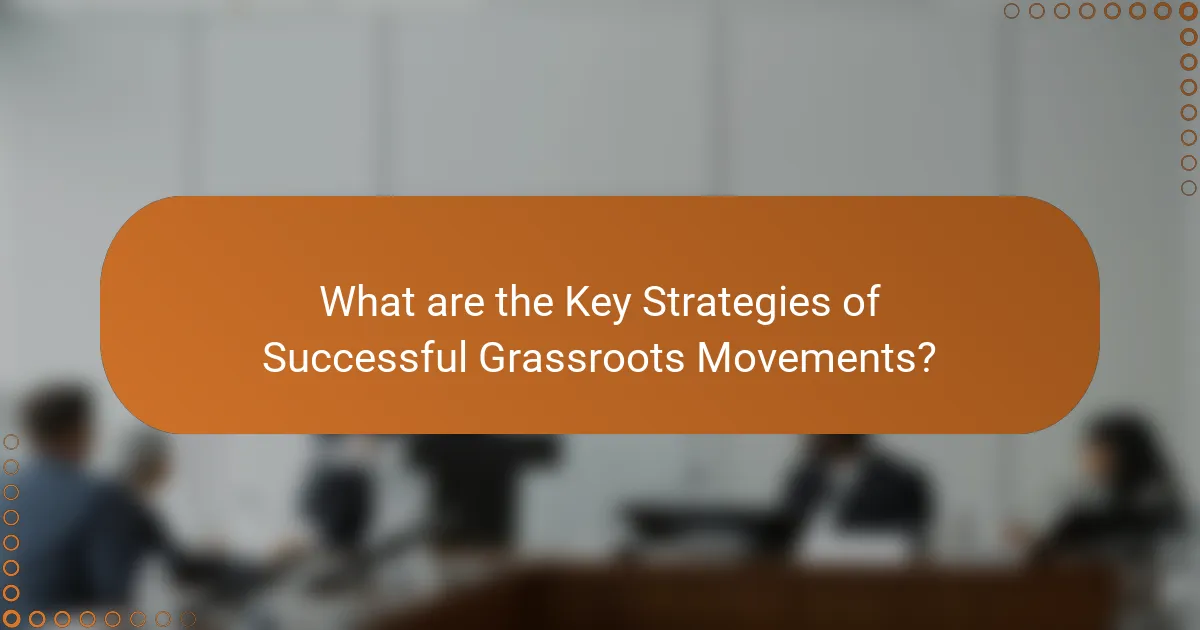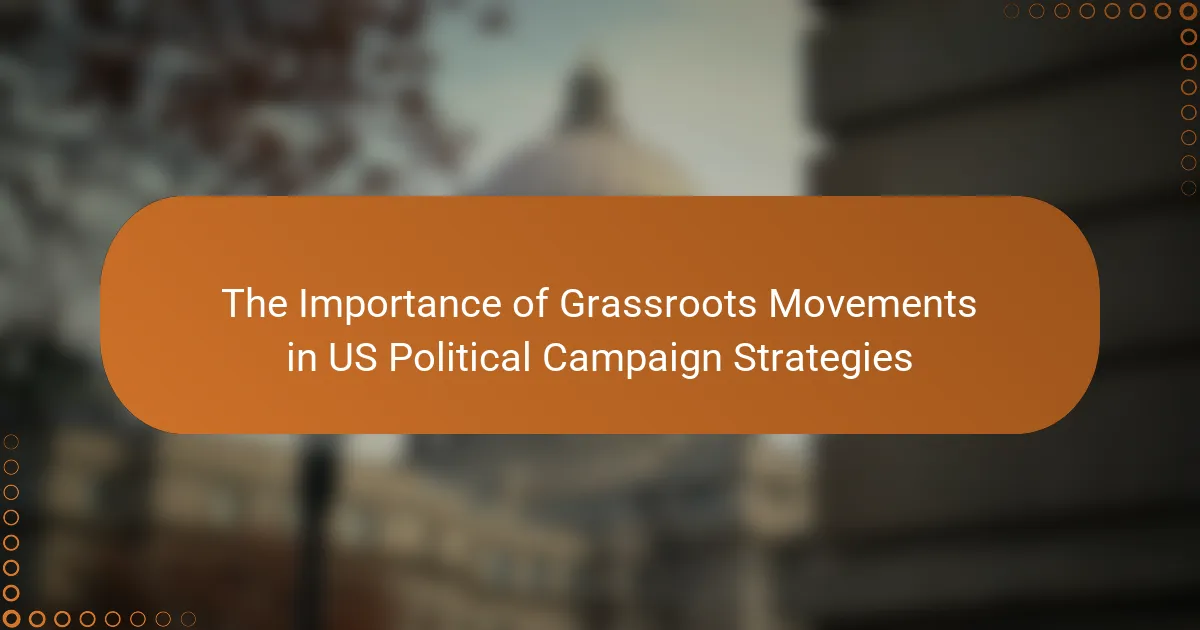Grassroots movements are organized efforts by ordinary individuals aimed at influencing political decisions across various levels in the United States. These movements are essential in political campaign strategies, as they engage communities to advocate for specific issues and candidates through methods such as social media outreach, local events, and door-to-door canvassing. The article explores the impact of grassroots movements on voter turnout, highlighting successful strategies such as community engagement, effective communication, and coalition building. It also discusses future trends, including increased digital engagement and a focus on local issues, which are expected to shape the landscape of political campaigning in the US.

What are Grassroots Movements and Their Role in US Political Campaign Strategies?
Grassroots movements are organized efforts by ordinary people to influence political decisions at local, state, or national levels. They often mobilize community members to advocate for specific issues or candidates. These movements play a crucial role in US political campaign strategies by fostering engagement and building support from the ground up. They utilize social media, local events, and door-to-door canvassing to connect with voters. Grassroots efforts can significantly impact election outcomes, as seen in the 2008 Obama campaign, which effectively harnessed grassroots support to mobilize millions of voters. Research shows that grassroots campaigns can increase voter turnout by as much as 20%.
How do Grassroots Movements differ from Traditional Political Campaigns?
Grassroots movements focus on mobilizing community members to advocate for change, while traditional political campaigns rely on established political structures and funding. Grassroots efforts often emphasize local engagement and volunteer participation. In contrast, traditional campaigns typically prioritize media advertising and professional consultants. Grassroots movements may emerge spontaneously, reflecting public sentiment and social issues. Traditional campaigns usually follow a structured timeline and strategic planning. Research shows that grassroots movements can increase voter turnout by fostering personal connections and community involvement. In 2018, the rise of grassroots campaigns significantly impacted elections, demonstrating their effectiveness in mobilizing support.
What are the defining characteristics of Grassroots Movements?
Grassroots movements are characterized by community-driven initiatives aimed at effecting social or political change. They typically emerge from the bottom up rather than being orchestrated by established institutions. These movements rely heavily on local participation and volunteer efforts. They often advocate for issues that resonate with the general public. Grassroots movements utilize social media and local networks to mobilize supporters. They emphasize inclusivity and democratic participation among diverse community members. Historical examples include the Civil Rights Movement and environmental activism. These movements can influence policy changes and raise awareness about critical issues.
How do Grassroots Movements mobilize community support?
Grassroots movements mobilize community support by engaging local individuals directly. They utilize personal connections to build trust and foster relationships. These movements often leverage social media to spread awareness and gather support. They organize community events to encourage participation and dialogue. Grassroots campaigns frequently focus on specific issues that resonate with the community. They empower individuals to take action through education and advocacy. Research shows that grassroots efforts can increase voter turnout significantly. For instance, a study by the Pew Research Center found that community-driven initiatives boost civic engagement.
Why are Grassroots Movements important in shaping political narratives?
Grassroots movements are crucial in shaping political narratives because they empower ordinary citizens to influence policy and public opinion. These movements often emerge from community needs and concerns. They mobilize individuals to advocate for specific issues, creating a collective voice. This grassroots activism can challenge established political narratives and introduce new perspectives.
For instance, the Civil Rights Movement significantly shifted public discourse on racial equality in the United States. Similarly, the Women’s Suffrage Movement transformed views on women’s rights. Grassroots movements utilize social media to amplify their messages, reaching broader audiences quickly. According to a 2020 study by the Pew Research Center, 69% of Americans believe that grassroots activism can lead to meaningful change in politics. Thus, grassroots movements play a vital role in shaping political narratives by fostering engagement and challenging the status quo.
How do Grassroots Movements influence public opinion?
Grassroots movements influence public opinion by mobilizing community members around shared interests and concerns. These movements often leverage social media to amplify their messages quickly. They create a sense of urgency and collective action, making issues more relatable to the public. Research shows that grassroots campaigns can shift public sentiment significantly. For example, the Tea Party movement in the U.S. altered conservative viewpoints on taxation and government spending. Additionally, grassroots movements often engage in door-to-door canvassing, which personalizes political messages. This direct interaction fosters trust and encourages individuals to express their opinions. Overall, grassroots movements serve as a powerful tool for shaping public discourse and opinion.
What role do social media and technology play in Grassroots Movements?
Social media and technology are crucial in grassroots movements. They facilitate rapid communication and organization among supporters. Platforms like Twitter and Facebook allow for instant sharing of information. This accelerates mobilization for events and campaigns. Technology enables targeted outreach to specific demographics. Data analytics help identify potential supporters and tailor messages effectively. Social media also amplifies the visibility of grassroots issues. For example, the #BlackLivesMatter movement gained global attention through online platforms. Studies show that social media engagement correlates with increased participation in protests and activism. Therefore, technology enhances the effectiveness and reach of grassroots movements.
What challenges do Grassroots Movements face in US Political Campaigns?
Grassroots movements in US political campaigns face several significant challenges. Limited funding restricts their ability to compete with larger, well-funded organizations. They often struggle to gain media attention, which is crucial for visibility. Additionally, grassroots movements may encounter bureaucratic obstacles when trying to navigate political systems. Mobilizing volunteers can also be difficult, especially in areas with low engagement. Furthermore, they often lack access to data and technology that larger campaigns utilize effectively. These challenges can hinder their overall impact and effectiveness in the political landscape.
How do funding and resources affect the success of Grassroots Movements?
Funding and resources significantly impact the success of grassroots movements. Adequate financial support allows these movements to execute campaigns effectively. It enables them to reach broader audiences through advertising and outreach efforts. Resources also enhance organizational capacity, allowing for better coordination and mobilization of volunteers. For instance, the 2018 midterm elections saw grassroots movements thrive due to increased funding, resulting in higher voter turnout. Additionally, access to resources can facilitate training for activists, improving their effectiveness. In contrast, limited funding often restricts a movement’s visibility and outreach. This dynamic illustrates how funding and resources directly correlate with the overall impact and success of grassroots initiatives.
What strategies can Grassroots Movements employ to overcome obstacles?
Grassroots movements can employ several strategies to overcome obstacles. Mobilizing community support is essential. This creates a strong base for advocacy and action. Utilizing social media effectively can amplify their message. Platforms like Twitter and Facebook can reach broader audiences quickly. Building coalitions with other organizations can strengthen their position. Collaborating with established groups can provide additional resources and credibility. Engaging in local events raises awareness and fosters connections. Direct outreach to community members can personalize their cause. Developing clear, compelling narratives can resonate with the public. Storytelling makes their issues relatable and urgent. Utilizing data and research can bolster their arguments. Concrete statistics can persuade skeptics and attract media attention. These strategies have been effective in various movements, demonstrating their practical application.
How do Grassroots Movements contribute to voter engagement?
Grassroots movements enhance voter engagement by mobilizing local communities to participate in the electoral process. They create a sense of ownership among citizens regarding political issues. This involvement often translates to increased voter turnout. For instance, movements like the Women’s March and Black Lives Matter have successfully galvanized large numbers of participants. According to a study by the Pew Research Center, grassroots initiatives can boost civic participation by 20% or more. These movements often utilize social media to spread awareness and organize events. They also provide resources and education on voting rights and processes. This grassroots approach fosters a more informed electorate, ultimately strengthening democracy.
What tactics do Grassroots Movements use to mobilize voters?
Grassroots movements mobilize voters through community engagement, direct outreach, and social media campaigns. They often organize door-to-door canvassing to connect with potential voters personally. This tactic fosters relationships and builds trust within the community. Additionally, grassroots movements utilize phone banking to reach voters effectively. They encourage supporters to call their networks and share information about voting. Social media platforms are leveraged to spread awareness and mobilize supporters quickly. Campaigns often create shareable content to engage a wider audience. Events such as town halls and rallies are organized to energize and inform voters. These tactics collectively enhance voter turnout and community involvement in the electoral process.
How effective are Grassroots Movements in increasing voter turnout?
Grassroots movements are highly effective in increasing voter turnout. They mobilize community members and foster engagement through local outreach. Research indicates that grassroots efforts can increase voter participation by up to 20%. For instance, the 2008 Obama campaign utilized grassroots strategies, resulting in a significant rise in turnout among young voters. Additionally, grassroots movements often address specific local issues, making voting more relevant to individuals. This connection encourages participation in elections. Studies show that personal interactions in grassroots campaigns lead to higher voter engagement. Overall, grassroots movements play a crucial role in enhancing voter turnout.

What are the Key Strategies of Successful Grassroots Movements?
Successful grassroots movements utilize several key strategies. These include community engagement, effective communication, and coalition building. Community engagement fosters local support and participation. It encourages individuals to take ownership of the movement. Effective communication ensures the message resonates with the target audience. This involves using social media, public events, and traditional media to spread awareness. Coalition building brings together diverse groups to amplify impact. Collaborations with other organizations can strengthen resources and reach. Mobilization of volunteers is crucial for executing campaigns. Grassroots movements often rely on volunteers for outreach and organizing efforts. Additionally, fundraising is essential to support activities and initiatives. Successful movements often leverage small donations from a large number of supporters. These strategies have been proven effective in various historical contexts, such as the Civil Rights Movement and recent environmental campaigns.
How do Grassroots Movements build coalitions and partnerships?
Grassroots movements build coalitions and partnerships by fostering community engagement and collaboration. They identify shared goals among diverse groups. These movements often utilize social media to connect and mobilize supporters. They organize events to raise awareness and encourage participation. Building trust is essential for effective partnerships. Grassroots organizations often emphasize transparency and mutual respect. They leverage existing networks to expand their reach. Successful coalitions frequently result in collective action that amplifies their voices in political discourse.
What are the benefits of collaborating with local organizations?
Collaborating with local organizations enhances community engagement. This partnership fosters trust and credibility among constituents. Local organizations possess valuable insights into community needs and preferences. They can mobilize grassroots support effectively. Collaborations can lead to increased voter turnout during elections. Studies show that campaigns working with local groups see a 20% rise in participation. Additionally, these partnerships can amplify messaging through established community networks. Overall, collaboration strengthens the impact of political campaigns.
How can Grassroots Movements leverage existing community networks?
Grassroots movements can leverage existing community networks by building on established relationships and trust. They can utilize local leaders to mobilize support effectively. Engaging with community organizations enhances outreach and resource sharing. Collaborating with these networks amplifies their message through word-of-mouth. Utilizing social media platforms within these communities can increase visibility. They can also tap into existing events to gather support and raise awareness. Research shows that grassroots campaigns with strong community ties experience higher engagement rates. This approach fosters a sense of ownership among community members, leading to sustained involvement.
What communication strategies do Grassroots Movements utilize?
Grassroots movements utilize various communication strategies to mobilize support and spread their message. They often rely on social media platforms for outreach and engagement. These platforms allow for real-time communication and community building. Grassroots movements also use local events to foster face-to-face interactions. This helps to strengthen community ties and build trust. Additionally, they create compelling narratives to resonate with their audience. Storytelling helps to humanize issues and create emotional connections. Grassroots movements frequently engage in direct action campaigns to raise awareness. These actions can include protests, sit-ins, or community service initiatives. Together, these strategies enhance visibility and encourage participation in the movement.
How do Grassroots Movements craft their messaging for maximum impact?
Grassroots movements craft their messaging for maximum impact by focusing on relatable narratives. They emphasize personal stories to connect emotionally with audiences. This approach fosters a sense of community and shared experience. Clear and concise messaging is prioritized to enhance understanding. They often leverage social media for broader outreach and engagement. Targeted campaigns are tailored to specific demographics to increase relevance. Research shows that emotionally charged messages can boost engagement by up to 30%. By utilizing these strategies, grassroots movements effectively mobilize support and drive action.
What role does storytelling play in Grassroots communication?
Storytelling plays a crucial role in grassroots communication by creating emotional connections. It helps convey messages in a relatable and engaging manner. Grassroots movements often utilize personal narratives to illustrate shared experiences. This approach fosters community engagement and solidarity among supporters. Research shows that emotionally resonant stories can enhance message retention. For instance, a study by the Stanford Graduate School of Business found that stories are 22 times more memorable than facts alone. Effective storytelling in grassroots communication mobilizes individuals and encourages action. It transforms abstract issues into personal stakes, motivating grassroots participation.
How do Grassroots Movements measure their success?
Grassroots movements measure their success through various metrics. They often assess engagement levels, such as the number of volunteers and participants in events. They track social media interactions, including likes, shares, and comments. Fundraising totals provide insight into financial support and community backing. Additionally, they evaluate policy changes or political outcomes influenced by their efforts. Surveys and feedback from supporters help gauge public sentiment and awareness. These metrics collectively indicate the effectiveness of their strategies and campaigns. For instance, the 2018 midterm elections saw a significant increase in voter turnout attributed to grassroots mobilization efforts.
What metrics are used to evaluate the effectiveness of Grassroots efforts?
Common metrics used to evaluate the effectiveness of grassroots efforts include engagement levels, volunteer participation, and fundraising success. Engagement levels can be measured through social media interactions and event attendance. Volunteer participation is assessed by tracking the number of active volunteers and hours contributed. Fundraising success is evaluated by the total amount raised and the number of donors. Additionally, voter turnout in targeted areas serves as a critical metric. These metrics provide concrete data to measure the impact and reach of grassroots initiatives.
How can Grassroots Movements adapt based on feedback and results?
Grassroots movements can adapt based on feedback and results by actively collecting and analyzing input from their community. They utilize surveys, social media interactions, and community meetings to gather insights. This feedback helps identify areas for improvement and success. Movements can adjust their strategies accordingly to better align with community needs. For instance, specific messaging can be refined based on what resonates with supporters. Additionally, they can pivot their tactics in response to changing political landscapes or community priorities. Historical examples include movements that shifted focus based on election outcomes or public sentiment. By remaining flexible and responsive, grassroots movements enhance their effectiveness and engagement.

What are the Future Trends for Grassroots Movements in US Political Campaigns?
Future trends for grassroots movements in US political campaigns include increased digital engagement, enhanced data analytics, and greater focus on local issues. Digital platforms allow grassroots movements to mobilize supporters quickly. Social media campaigns can reach wider audiences at a lower cost. Data analytics enables targeted outreach, helping campaigns identify and connect with potential voters effectively. Additionally, grassroots movements are likely to prioritize local concerns to resonate with communities. Research shows that local issues drive voter engagement and turnout. Collaborations with local organizations can amplify grassroots efforts. These trends reflect the evolving landscape of political campaigning in the US.
How are Grassroots Movements evolving in response to changing political landscapes?
Grassroots movements are evolving by leveraging technology and social media to mobilize support. These platforms allow for rapid communication and organization among supporters. Movements adapt their strategies to reflect the changing political climate. For example, they focus on local issues that resonate with communities. This shift helps them engage a broader audience. Additionally, they emphasize inclusivity and diversity in leadership. Research shows that movements with diverse leadership are more effective in achieving their goals. The rise of digital activism has also transformed traditional campaigning methods. These changes reflect a response to political polarization and public demand for accountability.
What impact do emerging technologies have on Grassroots strategies?
Emerging technologies significantly enhance grassroots strategies. They provide new platforms for communication and engagement. Social media allows grassroots movements to reach wider audiences quickly. Data analytics enable targeted messaging to specific demographics. Mobile apps facilitate organization and mobilization of supporters. Crowdfunding platforms help raise funds efficiently. These technologies lower barriers to entry for participation. As a result, grassroots movements can operate more effectively and influence political outcomes.
How are new generations influencing the direction of Grassroots Movements?
New generations are significantly influencing the direction of grassroots movements through their engagement and innovative approaches. They leverage social media platforms to mobilize support quickly and effectively. This demographic prioritizes inclusivity and diversity in advocacy efforts. Young activists often focus on issues like climate change, social justice, and equity. Their preference for direct action over traditional methods reshapes campaign strategies. Data shows that youth-led movements, such as the March for Our Lives, have gained substantial traction and visibility. Additionally, younger generations value transparency and accountability from leaders. This demand drives grassroots organizations to adopt more democratic practices. Overall, new generations are redefining the landscape of grassroots movements with their unique perspectives and tools.
What best practices can Grassroots Movements adopt for future campaigns?
Grassroots movements can adopt several best practices for future campaigns. First, they should prioritize building a strong community network. Engaging local supporters fosters trust and loyalty. Second, utilizing social media platforms effectively amplifies their message. For instance, campaigns that leverage platforms like Twitter and Facebook can reach wider audiences. Third, grassroots movements should focus on clear messaging. A concise and compelling narrative resonates better with potential supporters. Fourth, they must implement data-driven strategies. Analyzing voter demographics helps tailor outreach efforts. Fifth, collaboration with local organizations enhances credibility. Partnerships can provide additional resources and support. Lastly, training volunteers is crucial for campaign success. Well-prepared volunteers can engage more effectively with the community. These practices have been shown to increase voter turnout and mobilize support effectively.
How can Grassroots Movements effectively engage diverse communities?
Grassroots movements can effectively engage diverse communities by fostering inclusive dialogue. They can organize community meetings that invite participation from various cultural groups. Utilizing social media platforms allows for broader outreach and engagement. Providing translation services ensures language barriers are minimized. Collaborating with local leaders can enhance trust and credibility within communities. Conducting surveys helps to understand the specific needs and concerns of diverse populations. Research shows that inclusive strategies lead to higher community participation rates. For example, the 2020 election saw grassroots organizations successfully mobilizing underrepresented voters through targeted outreach efforts.
What innovative approaches can enhance Grassroots campaigning efforts?
Utilizing digital tools can enhance grassroots campaigning efforts. Social media platforms enable targeted outreach and engagement. Data analytics help identify and connect with potential supporters. Crowdsourcing ideas fosters community involvement and ownership. Mobile apps facilitate easy communication and organization among volunteers. Virtual events expand reach beyond local communities. Collaborative partnerships with local organizations amplify messages and resources. These approaches have proven effective in recent successful campaigns, demonstrating their impact on mobilizing grassroots support.
What practical tips can activists follow to strengthen Grassroots Movements?
Activists can strengthen grassroots movements by fostering community engagement. Building local networks enhances collaboration and trust. Organizing regular meetings allows members to share ideas and strategies. Utilizing social media effectively amplifies messages and increases visibility. Training volunteers in advocacy skills empowers them to take action. Collaborating with local organizations broadens support and resources. Fundraising efforts can provide necessary financial backing for initiatives. Lastly, celebrating small victories motivates continued participation and commitment.
Grassroots movements are organized efforts by ordinary individuals aimed at influencing political decisions across various levels in the United States. This article explores their critical role in political campaign strategies, emphasizing their ability to mobilize community support, enhance voter engagement, and challenge established political narratives. It highlights the differences between grassroots movements and traditional campaigns, the defining characteristics of grassroots initiatives, and the impact of social media and technology on their effectiveness. Additionally, the article addresses the challenges these movements face, strategies for overcoming obstacles, and future trends shaping their evolution in the political landscape.
